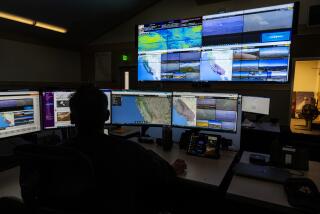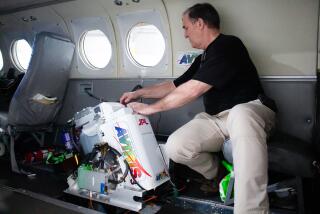A mini-fridge-size satellite could help troops get a real-time view of the upcoming battlefield
- Share via
A network of tiny satellites as small as a dorm-room refrigerator could one day give military troops on the ground a real-time look at what’s lurking over the next hill.
The first of these satellites, known as Kestrel Eye, will be launched Monday morning aboard a SpaceX Falcon 9 rocket loaded with NASA supplies for the International Space Station.
If this demonstration is successful, the U.S. Army eventually could send a few dozen more satellites to low-Earth orbit. It’s another sign of how increasingly capable small satellites are finding their way into an array of private and government applications, including commercial imaging, scientific missions and broadband Internet access.
Already, San Francisco-based Planet operates a small-satellite network to capture images of Earth, while Boeing Co., OneWeb and Hawthorne-based SpaceX are planning so-called constellations of satellites to provide broadband Internet access.
Now the military is joining in.
With Kestrel Eye — named after a small, sharp-eyed falcon — troops about to embark on a mission could go to a ground station and use a laptop that connects to a portable and lightweight antenna to pull up images of an area. The real-time information could tell them whether their plans need to be adjusted — if a previously empty field is now filled with vehicles, for instance.
Kestrel Eye images won’t be as high-quality as those from a larger military satellite, which can capture specific details such as faces or vehicle license plate numbers. With Kestrel Eye, troops will be able to see large vehicles like tanks or cars.
But for fighters on the ground, speed can trump detail.
“It’s all about trying to get information down to that low-level tactical warfighter rapidly,” said Chip Hardy, Kestrel Eye program manager at the U.S. Army Space and Missile Defense Command tech center’s space and strategic systems directorate.
Larger military satellites can provide area imagery, but with slower turnaround time because they often are tasked with many missions, said Bill Ostrove, aerospace and defense analyst at Forecast International.
Drones also can be helpful, but it takes time to fly out and check an area. And overhead aircraft aren’t exactly covert.
Using a small satellite for this mission means development and launch costs can remain low, Hardy said. Lower costs and quicker production times also give the military the option of launching these satellites rapidly as needed.
The Kestrel Eye demonstration satellite was constructed by Adcole Maryland Aerospace, a small satellite and spacecraft manufacturer with locations in Massachusetts and Maryland. The U.S. Army Space and Missile Defense Command/Army Forces Strategic Command oversaw the effort and provided technical guidance.
Though the military has been slower to adopt small satellites than the commercial sector, these tiny spacecraft eventually could complement larger, traditional satellites.
“You’ll have some missions that can be done by a smaller satellite that can be much cheaper and more responsive, and the larger and more strategic missions will be conducted by these larger satellites,” Ostrove said.
SpaceX’s Dragon cargo capsule is expected to reach the space station Wednesday. The crew then will remove the satellite from the spacecraft and deploy it to orbit.
Kestrel Eye will participate in Army exercises throughout the year and will be evaluated for its utility, Hardy said.
Twitter: @smasunaga
ALSO
Boeing wins Air Force contract for two 747s that will become future Air Force One aircraft
Ground equipment problem marred Rocket Lab test flight in May, review says
In the latest twist for space start-ups, a rocket roars off a country road in Georgia
More to Read
Inside the business of entertainment
The Wide Shot brings you news, analysis and insights on everything from streaming wars to production — and what it all means for the future.
You may occasionally receive promotional content from the Los Angeles Times.











